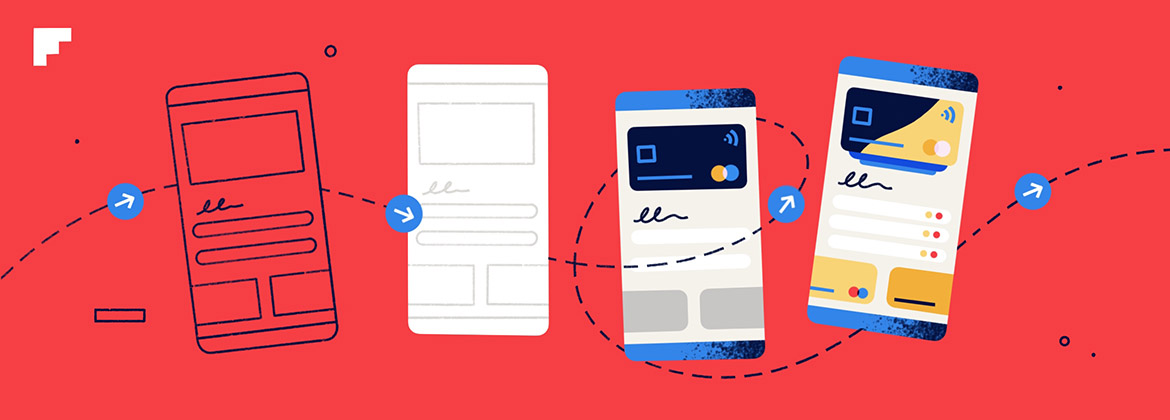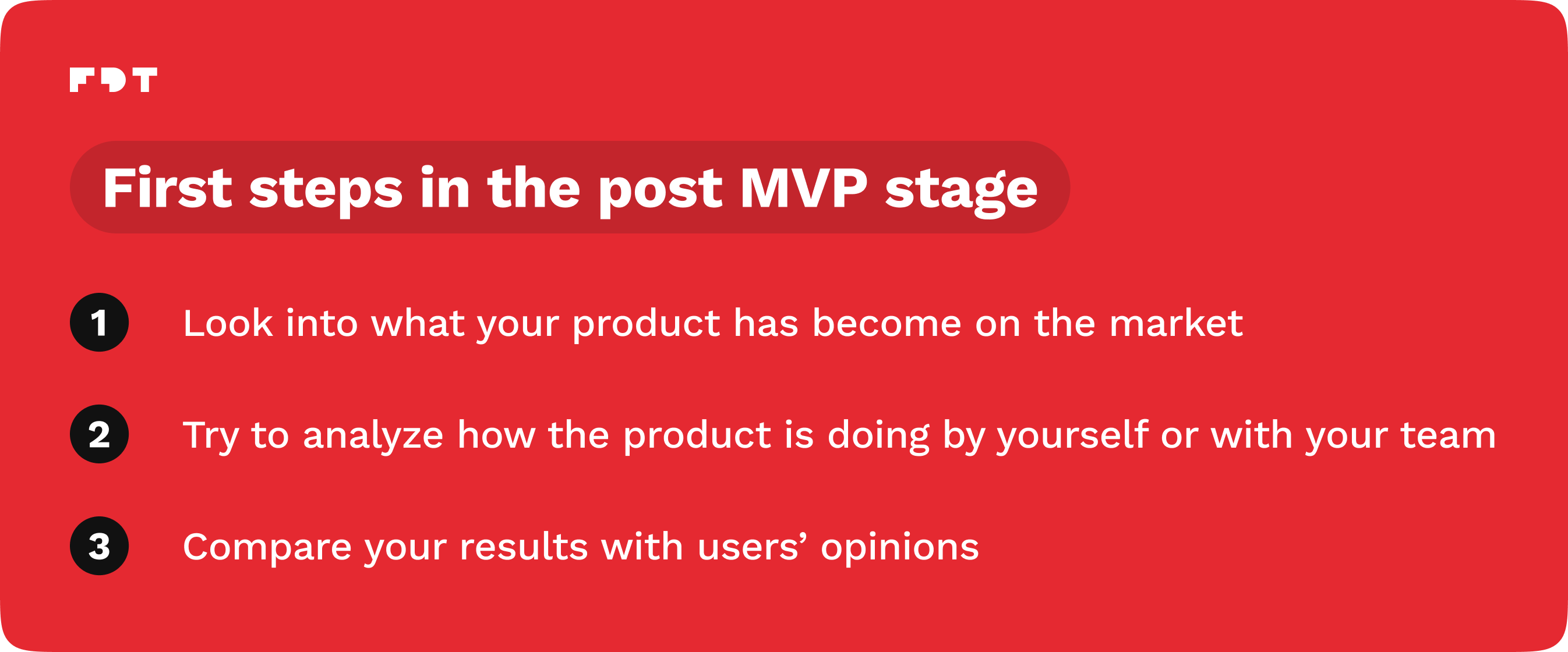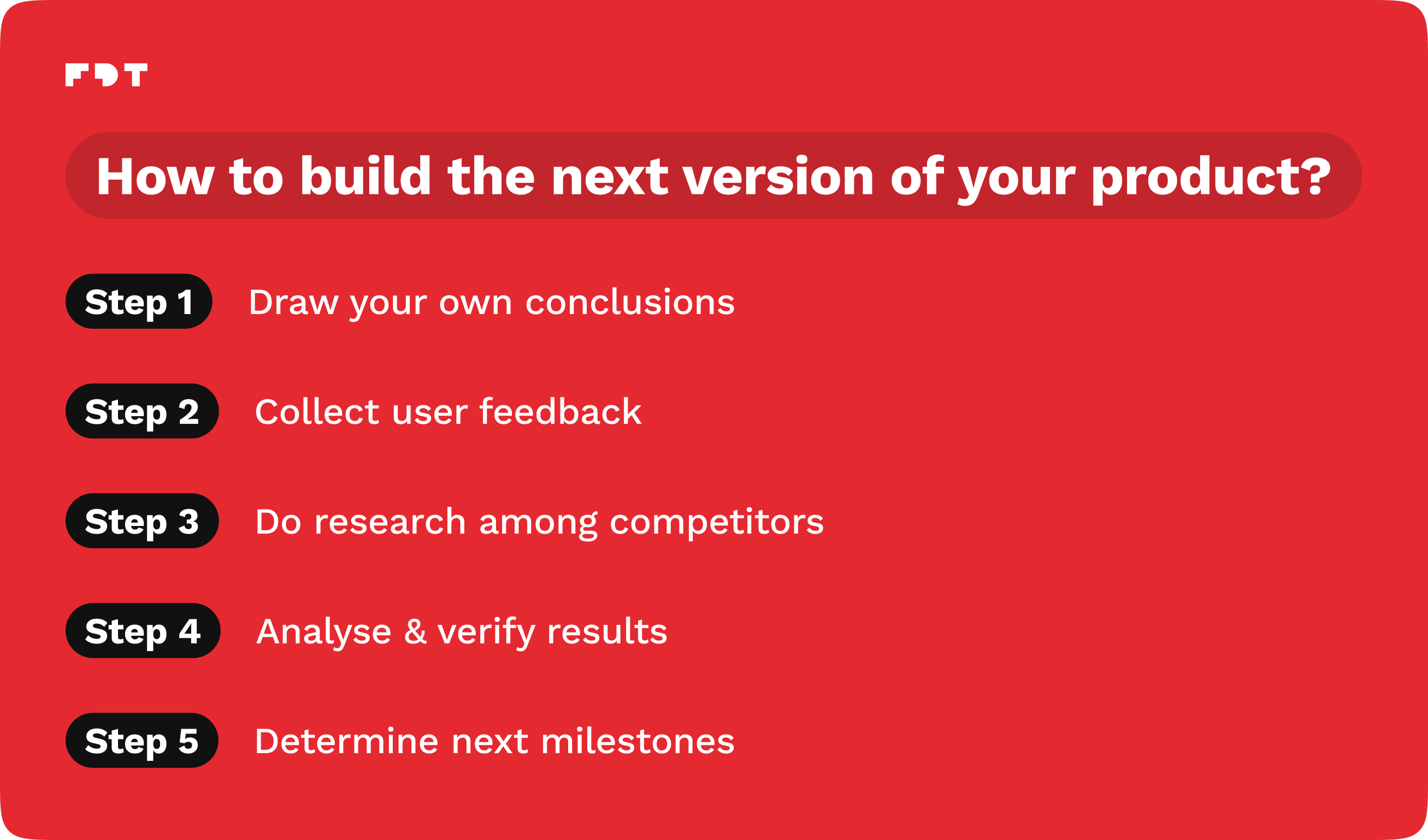
Post MVP stage: How to build the next version of your product?
So you’ve built a minimum viable product for your business and now it is time to think about what should be done next to grow it even bigger and spread your app’s wings. You need to get to work on the next version of the product along with your team.
What should it be like to maintain the quality level or (that’s the purpose) increase it? What should you pay attention to before planning what to plan next? Find answers (formed with the help of our CEO and Project Manager) to these and other questions below and let’s determine what the post-MVP development process should look like.
Contents
Minimum viable product (MVP)
For those who came here not only to discover post-MVP actions worth taking, a short definition:
A minimum viable product (MVP), also called a minimum marketable product, is a mobile app with a minimum set of features. You can build this kind of app to save money and see if your business idea is a good one. Usually, it contains fewer features than the planned-for-later complex solution. By default, when building an MVP, your goal is to expand it later, of course, if the first version met your expectations.
So basically, a minimum viable product is made to provide your target audience with the most important features, release the product as soon as possible and check if it fits the market.
MVPs are often over-interpreted. It is useful to think of the process of building a minimum viable product as delivering something remarkably simple quickly, which will meet the expectations of the target audience. When planning to create a minimum marketable product, it’s good to follow the “Less is More” principle.
You can find out more about it in this article.
When to build the next version of an MVP?
When is the best time to start working on the new version of your product? Basically, right after the release of an MVP. Perhaps not in every case, but in most situations and for most businesses it’s crucial to be aware that the next version is needed among your users and should be planned right away. After the release of the second version of your app, it will be time for the next one, so you can say that the creation of an app each time is related to planning the next iteration of it, all the time.
It is time to develop your product and your business
So where to start when you know you need to start developing an MVP further to ensure the success of your app? Firstly, let’s remember that a minimum marketable product is meant to enable you to test the market needs and to prove the viability of your solution. That’s exactly what has to be done.
How to build the next version of the product?
Follow the steps below to ensure everything is happening in an organised and reasonable manner.
Draw conclusions
It is necessary to learn from what has been delivered, allow yourself to take a retrospective and confront it with the actual market response. In other words:
- Look into what your product has become on the market
- Analyze how the product is doing
- Compare your results with users’ opinions.
Having your conclusions compared with the real results you can get by collecting feedback is important. That’s why at this stage you should take a look at the overall performance of the minimum marketable product and analyze the product’s success (so far).
Collect user (customer) feedback
Listen carefully to the users of your app. It is essential because your product is meant to serve them and suit their needs. Your profits and success are only the effects of users’ satisfaction.
So it is best to allow the early adopters (first users of your app) to provide feedback on the app. Your task will be to study it comprehensively and analyze all the features they:
- like
- find unnecessary
- think are missing and would like to see in your app.
How to do it?
Where exactly to look for users’ opinions and how to find out what they need?
There are various ways to test the above matters. Enable sending feedback straight from your app, look at ratings and reviews in Google Play Store and Apple App Store, follow what users say about the product on social media, perform community interviews, and read the comments users send to support (because there is a support contact, right?).
It is also important to simply listen to what is happening in the market and be aware of the trends.
How to use customer feedback?
The more you will be able to extract from the content of your customers' opinions, the easier it will be to decide what the product should look like and what features it should include.
Maybe some features were in fact unnecessary and others will be worth developing, or perhaps users will point out some bugs that need to be eliminated.
As a result, customer feedback will help you build an outstanding product tailored to the customer's needs. You will learn which features are the most valuable for users and at the same time, it will be a hint on what should be included in the next version’s feature set.

Check things with your competitors
Another factor determining your success will, of course, be your competitiveness. You should constantly review what your competitors are up to and compare their products with yours.
What have you not yet implemented that your competitors already have? When building the next version of your product, you no longer need to focus only on core functionality (minimum marketable feature). You can get inspired by the competition and add new features to make your app more and more attractive.
It is also useful to pay attention to how users of competing products respond to their apps. Notice what bothers them and what they appreciate, both in products that are MVPs and those that are already highly advanced.
Analyse & verify results
As mentioned earlier, the results need to be thoroughly analyzed. You can do this manually and automatically; the best way is to combine both of these.
A minimum viable product delivered in the Scrum methodology already gives a lot of knowledge to the team and is full of information about the delivery flow of incremental value in the project. So with the execution time data, you can already learn a lot about your team's performance. It is not just about control but a viable assessment of what you can deliver within a certain timeframe.
Data-driven product development
You should also verify what has basically worked well as it should and what needs to be changed. You can use, for example, analytics tools to assess this. It is best to set up such a tool or multiple ones right before the minimum marketable release.
Measuring the user behaviour in your app will help you to make better decisions and identify what’s worth improving and what’s better left without any changes.
Determine milestones
It is time to establish the next milestones that will deliver the greatest value to investors and target users. When setting these and already creating specific tasks for the team, do not forget that the main goal of any application development project is for the user (i.e. the customer) to value your product.
However, this is a phase where we are dealing with a kind of game where sometimes you will have to choose between what is cost-effective and what is very time-consuming.
Sometimes it can be difficult to decide whether, at a given stage, it is better to save time and resources and release a less developed version, or to invest more to create a version that fulfils your objectives completely.
Establish the next steps with the product development team
There might come a time when you will consider changes to your product team. You may want to hire new people or change the team completely. You also may want to use an outsourced app development team.
However, it is advisable to think it through and not make rush decisions.
Consider what will work best in your situation, as perhaps the next phase should be implemented with the same team. Within the project implementation, the team became more aware and wiser with each iteration.
So even if there were some problems, there is a good chance that the next stages will be realised more effectively.

Bonus hints
Let’s explore some additional hints for you to facilitate planning the development process for your product.
Don’t hurry with the development process
Building the next version of your product requires as much planning and prioritisation as an MVP development, to make the right decisions. You probably already have a few ideas for new features in your backlog, but in order to choose the right ones and start building them, take a look at what you've learned from analysing user feedback.
Don't implement everything on your list at once, but develop your product progressively, according to user needs.
UI/UX audit
If your MVP development included creating simple designs, it might be a very good idea to take advantage of experienced designers and ask to do an audit. UI and UX designers check the overall look of the app and examine specific elements to assess whether the app looks and works well according to current standards.
That might seem like the less important matter but let’s not forget that your app is supposed to be developed and extended over and over again. You don’t want to follow outdated standards in the next versions of your product.
Consider hiring a marketing specialist
Since the MVP has validated the idea for your app, you've gathered users and you're thinking about developing your product, it might be the right time to hire a marketing specialist. Your product is ready to be promoted and gain more users, and a good growth specialist will help you do this.
Conclusion
It may be hard to decide which matters are the most important with each new version you start planning. Every time you struggle with such a decision, ask yourself a question: what is the actual purpose?
If, for example, the purpose of the next version release is primarily to get rid of bugs that users of your app reported, probably the best idea will be to act quickly with quality assurance specialists and let users enjoy an error-free product!
If, on the other hand, there will be time to improve the overall look and feel of the app, you’ll need to put more effort into UI and UX design, get the right people to work and forget about coding new features for a while.
It all depends and will always depend on your audience and the market needs.







